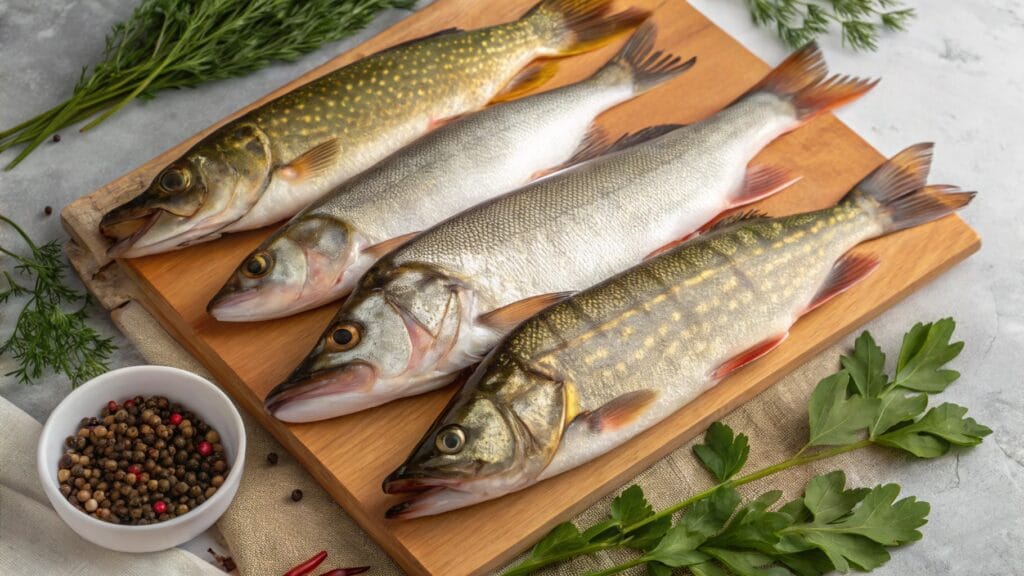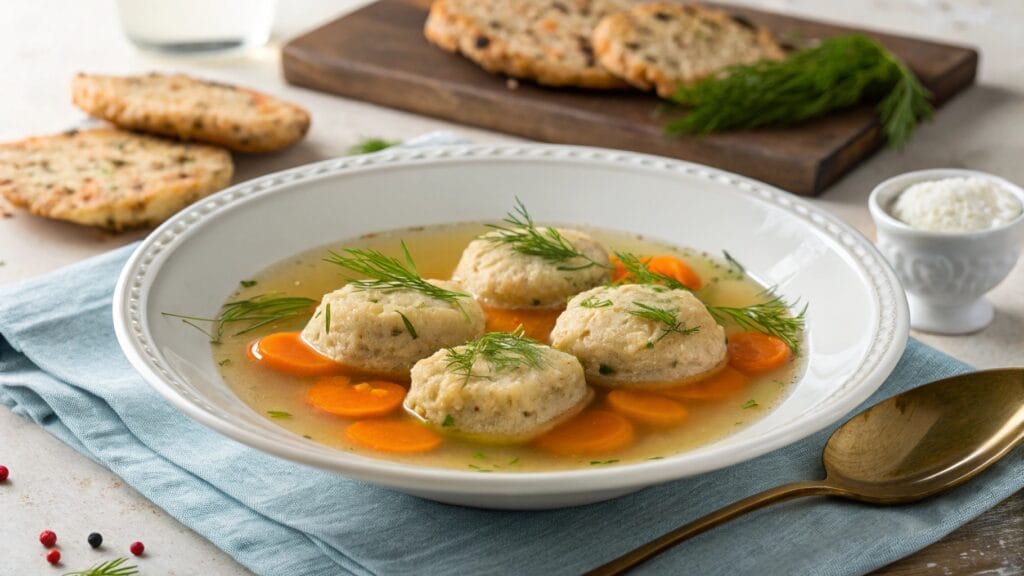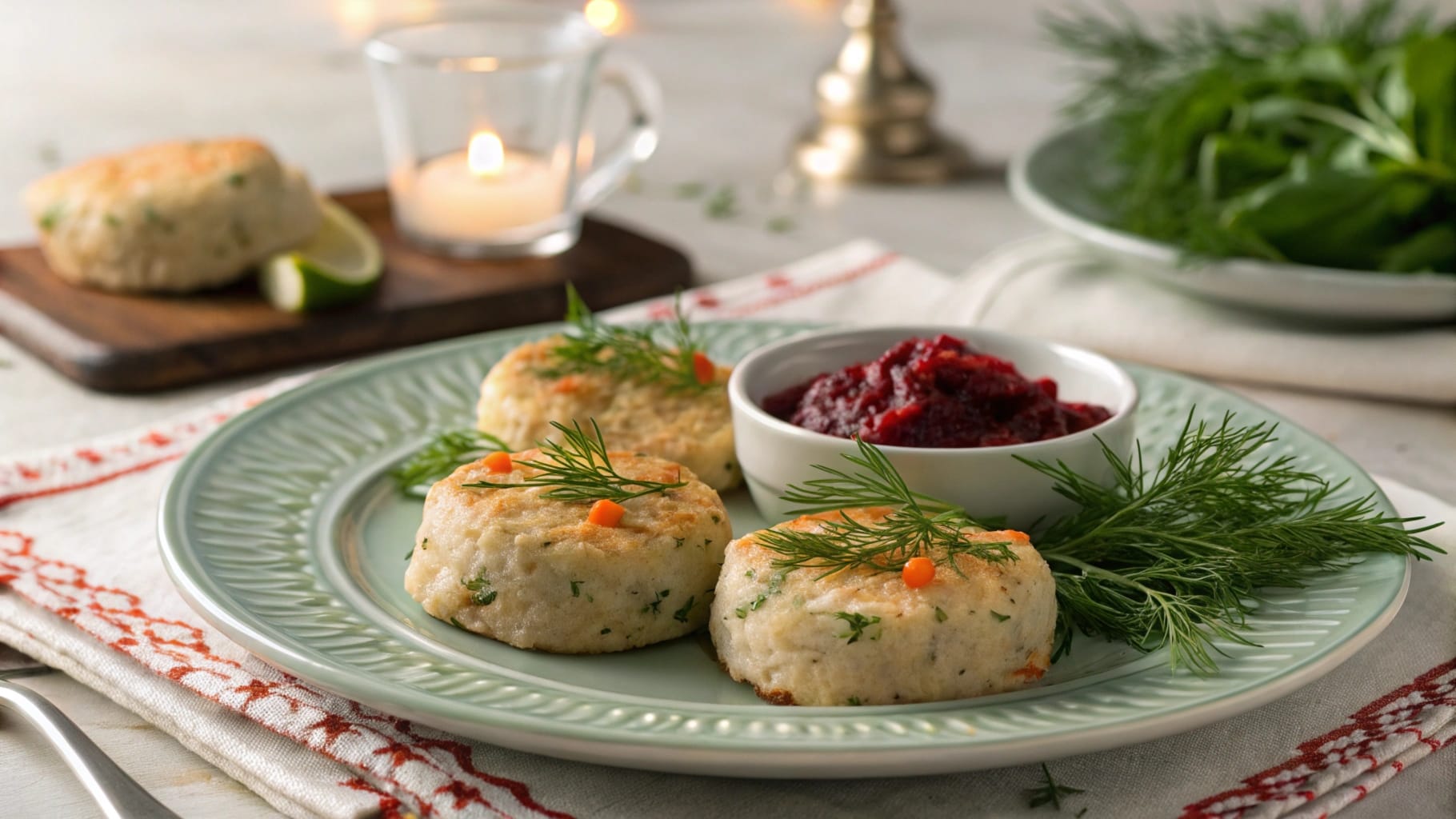Looking for the perfect gefilte fish recipe to impress your guests or celebrate a special occasion? This traditional Jewish dish can seem intimidating at first, but with the right guidance, anyone can master the art of making flavorful gefilte fish from scratch. In this step-by-step guide, we’ll walk you through everything you need to know—from selecting the best fish to crafting the perfect broth and troubleshooting common issues. Whether you’re a beginner or experienced cook, you’ll find all the tips and tricks you need to make this beloved recipe at home.
Looking for the perfect gefilte fish recipe? Whether you’re preparing it for a special occasion or just craving this classic dish, this gefilte fish recipe will guide you step-by-step to create the most delicious, flavorful result
What is Gefilte Fish? A Brief History and Origins
Before you can understand how to make gefilte fish, it’s good to know a bit about where it comes from. This dish has been a staple in Jewish cuisine for centuries, and its origins are tied closely to Jewish communities in Eastern Europe. “Gefilte” means “stuffed” in Yiddish, which makes sense when you consider the classic method of stuffing fish with a flavorful mixture of ground fish, breadcrumbs, eggs, and seasoning.
Interestingly, gefilte fish didn’t start out as a fancy dish; it was actually a practical solution to a common problem. Jewish law prohibits mixing meat and dairy, but fish can be served with dairy. So, gefilte fish was born as a way to make fish more filling and economical by grinding it up and making a “stuffed” version that could serve many people. It was also a way to stretch fish when it was expensive or scarce.
Gefilte fish became particularly popular in Ashkenazi Jewish communities, but variations of this dish can be found all over the world, from Israel to the United States, and beyond.
Traditional Gefilte Fish vs. Modern Variations: What You Need to Know
The Traditional Ingredients of Gefilte Fish
If you’re going for a truly traditional gefilte fish recipe, you’ll be working with a few key ingredients: white fish, carrots, onions, and seasoning. The white fish is typically a combination of pike, whitefish, and sometimes carp. These fish are ground up and combined with breadcrumbs, eggs, and other seasonings to form a cohesive mixture that’s then shaped into oval patties or quenelles.
The key to traditional gefilte fish is in the broth. The ground fish mixture is cooked in a flavorful broth made from the fish heads, bones, and vegetables, adding rich, savory flavor. This broth is then used to keep the fish moist and infuse it with additional taste.
Traditional serving usually includes a bit of horseradish on the side to add a spicy kick, but more on that later!
How Modern Twists are Changing the Classic Recipe
While traditional gefilte fish remains a favorite for many, there are also plenty of modern adaptations. For example, some people swap out the fish entirely, using salmon or trout for a fresher, lighter flavor. Others may opt for a gluten-free version, using almond flour or rice flour instead of breadcrumbs.
In addition to the classic fish combination, some modern cooks like to add vegetables, like celery or parsnips, or even use herbs like dill or parsley for extra flavor. These tweaks can make the dish lighter, healthier, and more in line with contemporary tastes.
How to Prepare Classic Fish Patties from Scratch: Ingredients & Tools
Now that you know a bit about what gefilte fish is and how it’s evolved, it’s time to get into the nuts and bolts of the recipe itself. First things first: you need the right ingredients and tools.
Key Ingredients You Need for Perfect Gefilte Fish
Here’s a list of the traditional and modern ingredients you’ll need to make a delicious batch of gefilte fish:

Traditional Ingredients:
- White fish (pike, whitefish, carp) – usually around 2–3 pounds of fish fillets.
- Onions – 1 large onion, finely chopped.
- Carrots – 2 medium-sized carrots, peeled and sliced.
- Breadcrumbs – 1 cup (or almond flour if you’re going gluten-free).
- Eggs – 2 large eggs.
- Sugar – 1 tablespoon (this helps to balance the flavors).
- Salt & pepper – To taste.
- Garlic – 1 clove, minced (optional, but adds flavor).
- Fish stock or water – For cooking the gefilte fish.
Modern Variations:
- Herbs – Fresh dill or parsley can be added for extra flavor.
- Trout or salmon – As a lighter, more contemporary option for fish.
- Vegetables – You can add finely chopped celery, leeks, or parsnips for a more veggie-rich version.
Essential Kitchen Tools for Preparing Gefilte Fish
Making gefilte fish involves a few essential tools. Here’s a quick list of what you’ll need:
- Food processor or meat grinder – to grind the fish into a smooth mixture.
- Large mixing bowl – for combining the ingredients.
- Large pot – for simmering the gefilte fish and making the broth.
- Slotted spoon – for carefully removing the fish patties from the broth.
- Cutting board and knife – for chopping the vegetables.
- Wooden spoon – for stirring the broth and mixing the fish mixture.
Having the right tools will make the process easier, and more importantly, it’ll help you create perfect gefilte fish every time!
Step-by-Step Instructions for a Classic Fish Dish
Preparing the Fish: Choosing the Right Fish Types
When choosing your fish, you want to go for a combination of mild, white fish like pike, whitefish, and carp. The fish should be fresh (not frozen), and you can ask your local fishmonger to fillet them for you. If you can’t find these specific fish, trout or salmon are great alternatives that can still give you a nice, smooth texture.
Pro tip: If you can’t get the fish fillets directly, you can buy whole fish and ask your butcher or fishmonger to clean and fillet them for you.
Once you have your fish, you’ll need to grind it. You can use a food processor to grind it into a fine, paste-like consistency, or use a meat grinder for a more traditional approach. You want the texture to be smooth, not chunky, so take your time to grind it well.
The Perfect Grounding Process: Texture and Consistency Tips
Grinding the fish properly is key to the texture of your gefilte fish. If the texture is too coarse, the patties won’t hold together as well. If it’s too smooth, it could turn out too mushy.
- First grind: Pass the fish through your food processor or grinder once.
- Second grind: For a smoother texture, grind it a second time.
Block quote:
“The right texture makes all the difference. Aim for a smooth paste, but not so smooth that it loses its shape when cooked.”
Once your fish is ground, transfer it to a large mixing bowl.
Step-by-Step Instructions for Preparing Gefilte Fish (Continued)
Making the Broth: Flavoring and Seasoning Tips
Once your fish is ground and ready to go, it’s time to make the broth. This is where a lot of the flavor comes from, so it’s important to get it just right.
The key to a rich, flavorful broth is in the balance of vegetables, fish bones, and seasonings. Here’s how to prepare it:
- Prepare your vegetables: Slice up carrots, onions, and any other vegetables you want to include. Carrots give a sweet, earthy flavor, while onions add depth to the broth.
- Fish stock: If you’re using whole fish, don’t throw away the fish heads, tails, or bones! These add a rich, natural flavor to the broth. If you don’t have fish parts, you can use store-bought fish stock or even water with some added vegetable stock cubes.
- Simmering: In a large pot, combine the fish parts, sliced vegetables, and water or stock. Bring it to a boil, then reduce the heat to let it simmer gently for about 45 minutes. You want the broth to be full of flavor, so let it cook down a little and develop a rich taste.
- Seasoning: Add salt and pepper to taste, but don’t overdo it—remember that the fish will also absorb some of the broth’s flavors while cooking. You can also throw in a few bay leaves, garlic, or parsley for added flavor.
Pro Tip: Taste the broth as it simmers. You can always adjust the seasoning later, but it’s important to get that rich, savory base!
Shaping the Gefilte Fish: Tips for Evenness and Texture
Now that your fish mixture is ready and the broth is simmering, it’s time to form your gefilte fish patties or quenelles. This is where the magic happens!
- Shaping the mixture: Use your hands or two spoons to shape the ground fish mixture into oval-shaped patties. You can make them as big or small as you like, but medium-sized patties usually work best. You don’t want them too large, or they’ll have trouble cooking evenly.
- A trick for smooth shaping: If you find the mixture a bit sticky, wet your hands or dip your spoons in water. This makes shaping the fish a lot easier and helps the patties hold their shape.
- Placing in the broth: Gently drop each shaped patty into the simmering broth. They should float in the broth comfortably. If you’re making quenelles (oval, slightly elongated shapes), you can use two spoons to shape them.
How Long to Cook Gefilte Fish: Perfect Timing for Tenderness
This is where things can get a little tricky—cooking gefilte fish requires patience. You don’t want to rush the process, as the fish can become tough if overcooked.
- Simmer gently: Once the gefilte fish is in the broth, lower the heat so that the liquid is barely simmering. The fish should cook for about 1 to 1.5 hours. The key here is slow, even cooking. Too much heat can cause the fish to become dry and tough.
- Check for doneness: The gefilte fish is done when it is firm to the touch and holds its shape. You can also use a fork to check the texture—if it flakes easily, it’s ready.
Block Quote:
“Patience is key here. The slow simmer allows the flavors to develop, and the fish to cook perfectly without becoming rubbery.”
The Secret to a Flavorful Fish Broth: Avoiding Overcooking
One of the common issues with cooking gefilte fish is overcooking, which can lead to a bland or tough texture. To avoid this, here are some things to keep in mind:
- Keep it at a low simmer: Don’t let the broth boil vigorously. A gentle simmer will cook the gefilte fish slowly and evenly.
- Skim the broth: While cooking, you may notice some foam rising to the surface. Skim this off to keep the broth clear and flavorful.
- Taste the broth again: As the gefilte fish cooks, the fish will release its flavors into the broth. You might want to add a little more salt, pepper, or other seasonings during the cooking process.
Common Problems with Gefilte Fish Recipes and How to Fix Them
Making gefilte fish is a bit of an art, and like with any recipe, there can be a few hiccups along the way. Let’s look at some common problems and how to solve them so you can be prepared.
Problem 1: Gefilte Fish Turns Out Too Dry
Solution: How to Keep Gefilte Fish Moist and Flavorful
If your gefilte fish turns out dry, it’s usually because the mixture was too lean or the cooking process was too quick. Here’s what you can do:
- Add fat to the mixture: Adding oil, butter, or even a bit of chicken fat to the fish mixture will keep it moist. The fat helps to lock in moisture and makes the fish more tender.
- Don’t overcook: As mentioned earlier, overcooking is a common cause of dry fish. Be sure to cook it gently and for the right amount of time.
- Serve with broth: The broth is there for a reason! Don’t forget to serve the gefilte fish with the flavorful broth to keep it moist.
Problem 2: The Fish Broth Tastes Too Bland
Solution: Enhancing the Broth with Aromatics and Spices
If your broth lacks flavor, here are a few tricks to fix it:
- Add more seasoning: Salt and pepper are your friends, but don’t stop there! Try adding a little garlic, dill, or lemon juice to the broth.
- Simmer longer: Let the broth simmer for longer to develop deeper flavors. If you’re using fish bones, simmer them for at least 45 minutes.
- Add a little sugar: If the broth is too salty or bitter, a tiny bit of sugar can help balance the flavors.
Problem 3: Gefilte Fish Doesn’t Hold Together
Solution: Tips for Binding the Fish Mixture Perfectly
If your gefilte fish patties fall apart during cooking, the most likely cause is that the mixture lacks a good binding agent. Here’s how to fix it:
- Use breadcrumbs or matzo meal: If you’re going gluten-free, you can use rice flour or almond flour. These help bind the mixture and keep it together while cooking.
- Add eggs: Ensure you’re using enough eggs to bind the mixture. They help hold everything together while it cooks.
- Chill before cooking: If your mixture is too soft, refrigerate it for 30 minutes before shaping and cooking. Chilling helps the mixture firm up and hold its shape better.
Tips for Storing and Freezing Gefilte Fish
After all the effort of making your delicious gefilte fish, you might have leftovers (or want to make it ahead of time). Here’s how to store and freeze it for later:
How to Store Gefilte Fish for Freshness
- In the fridge: Store gefilte fish in an airtight container in the refrigerator for up to 3–4 days. Keep the broth with the fish to maintain moisture.
- In the freezer: To freeze gefilte fish, make sure it has completely cooled before placing it in a freezer-safe container or bag. Gefilte fish can be frozen for up to 3 months. Just thaw it in the fridge overnight before serving.

Conclusion: Mastering the Art of Gefilte Fish
By now, you’ve learned everything you need to create a perfect batch of gefilte fish from scratch. From understanding its origins to choosing the right ingredients and even troubleshooting common problems, you’re well on your way to impressing friends and family with this traditional, yet versatile dish.
Making gefilte fish can seem like a bit of a challenge at first, but the secret lies in patience and practice. With a little time, you’ll get the rhythm of shaping, cooking, and seasoning. Whether you stick to the traditional recipe or decide to add your own twist, gefilte fish is a dish that reflects both tradition and creativity.
And remember—cooking is about enjoying the process as much as it is about enjoying the meal. 🎣
Final Tips for Perfecting Your Gefilte Fish Recipe
Now that you’ve got the basics down, here are a few final tips to ensure your gefilte fish turns out just the way you want:
- Use Fresh Fish: The key to the best gefilte fish is always fresh fish. Fresh fish will give the dish a light, delicate flavor and texture. Avoid frozen fish if possible—unless you’re using high-quality frozen fillets, fresh fish is always the way to go.
- Get the Broth Right: As we’ve discussed, the broth is an essential part of the recipe. If you’re not making your own fish stock, choose a high-quality fish broth or make sure your water-based broth is well-seasoned. A bland broth can make or break the flavor of your gefilte fish, so don’t rush this step!
- Experiment with Flavor: Don’t be afraid to experiment with the seasoning. While traditional recipes use just the basics—salt, pepper, and sometimes sugar—you can also try adding other spices like paprika or cumin for a twist. Fresh dill or a squeeze of lemon juice at the end can also elevate the flavor.
- Don’t Skip the Chilling: If you find that your gefilte fish mixture is too soft, chill it for 30 minutes before forming the patties. This will make it easier to handle and help it hold together better during cooking.
- Cook Gently: When you place your patties into the simmering broth, be sure to cook them gently. A low simmer will give you the best texture. If the heat is too high, you risk the patties falling apart or becoming tough.
- Serve with a Smile: Finally, remember that presentation matters! Serve your gefilte fish with a generous helping of horseradish on the side for a sharp, spicy contrast. You can also add some fresh parsley or chopped vegetables to brighten up the dish and add a splash of color.
Serving Ideas: How to Serve Gefilte Fish for Maximum Enjoyment
- Classic Pairing: Serve gefilte fish with a dollop of horseradish or chrein (a tangy, spicy condiment). The cool heat of the horseradish is the perfect complement to the rich, savory fish.
- Add a Side of Pickles: Dill pickles or pickled vegetables are a classic pairing with gefilte fish. Their tangy crunch adds a delightful contrast to the soft, delicate fish.
- Serve with a Salad: A simple green salad with a light vinaigrette can balance the richness of gefilte fish and give the meal a fresh touch.
Health Benefits of Gefilte Fish: A Nutritious Meal Option
You might not expect gefilte fish to be particularly healthy, but this dish has a lot of nutritional benefits:
- High in Protein: Gefilte fish is an excellent source of lean protein, making it a great option for those looking to build muscle or maintain a healthy diet.
- Omega-3 Fatty Acids: If you use fish like salmon or trout, your gefilte fish will be packed with omega-3 fatty acids, which are good for heart health and can reduce inflammation.
- Low in Carbs: If you use a gluten-free option for the breadcrumbs, gefilte fish can be a low-carb meal, making it suitable for those on keto or low-carb diets.
- Rich in Vitamins and Minerals: Fish like pike and whitefish provide essential vitamins and minerals, including vitamin D, B vitamins, and selenium, which all contribute to your overall well-being.
Variations on the Classic Gefilte Fish Recipe: Creative Twists
While traditional gefilte fish is delicious, don’t hesitate to explore some variations. Here are a few ideas to spice things up:
- Add More Vegetables: You can sneak in some extra veggies, like celery, parsnips, or leeks. They add flavor and texture without overpowering the fish.
- Use Different Fish: Experiment with different types of fish, such as salmon, trout, or even tilapia. These options will give your gefilte fish a slightly different flavor profile, but they’ll still give you that tender, moist texture.
- Herb Infusion: Add fresh dill, parsley, or chives to the fish mixture for an herbal twist. This adds a fresh, fragrant note to the fish.
- Spicy Twist: For those who love a little heat, you can add a bit of chili powder or jalapeños to the fish mixture. Just be careful not to overdo it—balance is key!
In conclusion, mastering gefilte fish is all about understanding the balance of flavors, textures, and cooking techniques. Once you get the hang of the basics, the possibilities are endless! Whether you stick with the traditional recipe or decide to try out a modern variation, gefilte fish is sure to be a hit at any table. With a little practice, you’ll be making this dish like a pro and impressing your guests with every bite. 🌟
So roll up your sleeves, gather your ingredients, and get cooking! Happy feasting!

